
Latest News
- Hyundai E&C and KAERI Cooperate to Commercialize Next-Generation SMR, SFR
- Hyundai E&C to Fully Introduce HITTS, a Smart Safety System Specialized for Tunnels
- Hyundai E&C applies smart EV charging solution to apartment buildings for the first time
- Hyundai E&C wins one of the world’s top three design awards for four consecutive years
- Hyundai E&C Signs PPA for Solar Renewables with Glennmont D&D Solar Holdings
Just Like a Human Life, A Glimpse into Life of a Nuclear Power Plant
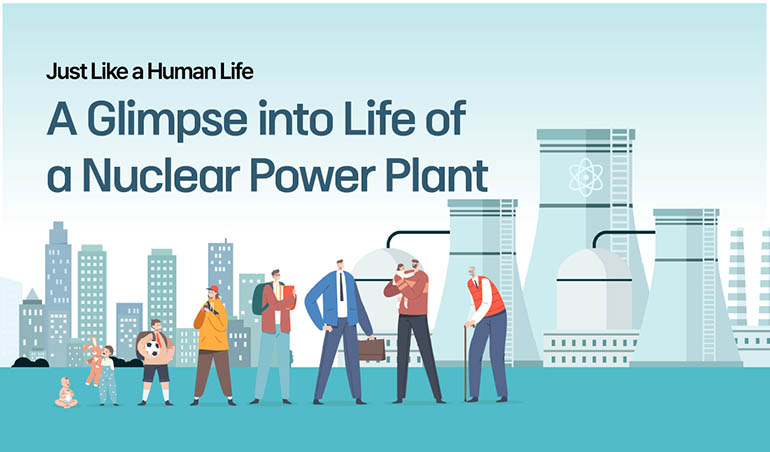
Birth and Retirement of A Nuclear Power Plant
Last year, nuclear power plants reached an eight-year peak, supplying over 30 percent of the nation's electricity. As Korea's main energy source for over 50 years, nuclear power is transitioning between generations. While new reactors are being built, such as Hyundai E&C's upcoming Shin Hanul Units 3 and 4, reactors built in the 1970s are either shutting down and awaiting decommissioning or delaying retirement and extending operations. Extended-life reactors generate as much power as they did in their heyday, and when they are fully decommissioned, their sites are returned to their original condition. Sounds a bit like a person entering old age, retiring from the workforce and moving onto a new chapter in life, doesn't it?
From birth to retirement, it can be said that the entire lifecycle of a nuclear power plant is in so many ways similar to that of a human being.
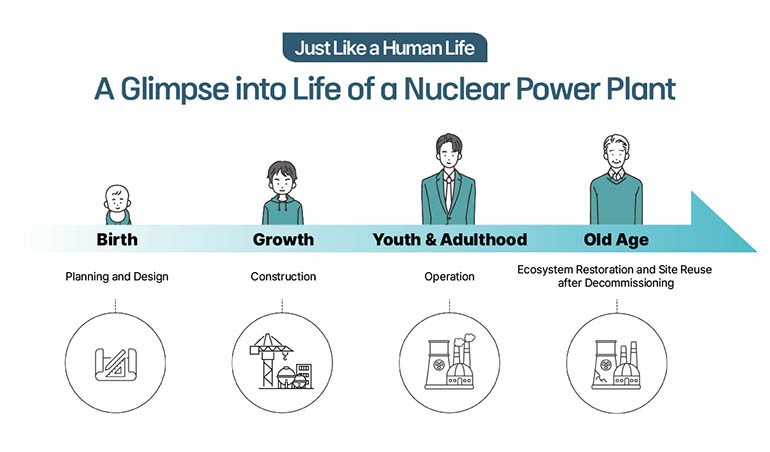
In particular, Kori NPP Unit 1, the founding project of Hyundai E&C's nuclear power plant business, is about to be decommissioned after nearly 40 years of operation as the first commercial nuclear power plant in Korea, giving us an insight into the life cycle of a nuclear power plant. Let's travel through the history of Kori Unit 1 from its birth to decommissioning, which tells a story much like of our own.
1962-1971 The Birth Planning and Design of NPP
Parents spend a lot of time preparing to welcome a new child into the world. They imagine what their child will look like and give him or her a nickname, or they prepare all the necessary items to ensure the child's health and happiness. Nuclear power plants also undergo a process of meticulous planning and design in the earliest stages, envisioning the birth of a safe nuclear power plant.
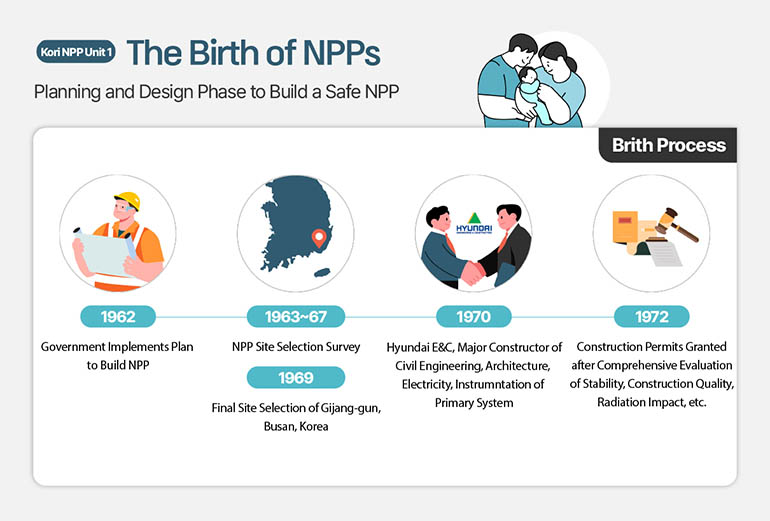
The birth of Kori NPP Unit 1, located in Gijang-gun, Busan, South Korea dates back to the 1960s. In 1962, the government initiated a plan to build a nuclear power plant in earnest. When planning a nuclear power plant, many complex factors must be carefully considered, including site selection, contractor selection, approvals and permits from relevant agencies, and design methods.
The Kori Unit 1 site was reviewed three times between 1963 and 1967. Just as a nurturing environment is important for a child, so too is finding the optimal location for a nuclear power plant, which, according to the Nuclear Safety Act, must be near an ocean or river for cooling water, geologically stable, and sparsely populated. This is why many nuclear power plants are located along the east coast of Korea. Korea Hydro & Nuclear Power (KHNP), which is in charge of the country's nuclear power plant business, scrutinizes these prominent conditions. At the time, the northern end of the Haengju Bridge was one of the candidate sites, but it was ruled out due to cooling water and security concerns, and the final site was chosen as Kori and Hyoam-ri vicinity in Jangan-eup, Gijang-gun, Busan. This is where the Kori Unit 1 was named after, and where the plant was born.
Over the next nine months, the government reviewed the stability and quality of construction, radiation impacts, etc. and gave the green light for construction of the Kori Unit 1.
The Kori Unit 1 was a symbol of Korea's modernization as it provided a stable energy supply that fueled the country's economic development. Hyundai E&C also made history by constructing the reactor system of the Kori Unit 1, and gaining experience through the first construction, the company successfully took the first step toward achieving independence in nuclear power technology in Korea, which led to successive orders for the Kori NPP Unit 2 and Wolseong NPP Unit 1 in the 1970s.
1971-1978 The Growth Construction of NPPs
Proper education of a child during the growing years becomes a habit and a foundation for later life. The same is true for nuclear power plants. Nuclear power plants can be dangerous if left unchecked, so every step of the construction process is thoroughly managed and adheres to the principles. Periodic inspections are also conducted to ensure that no single error is made.
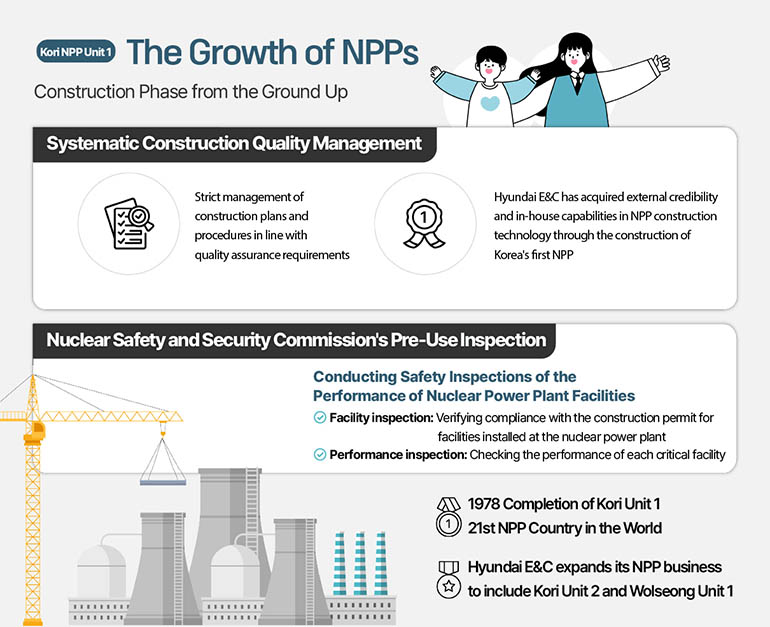
Hyundai E&C constituted a perfect construction plan and documented procedures, which were revised and supplemented repeatedly, to ensure solid construction of the Kori Unit 1. In the process, the company learned not only precise construction techniques, but also the importance of process procedures and quality control, which helped it take a step closer to achieving NPP technology in-house.
Periodic review of the construction status to ensure flawless construction is also an essential step in the growth phase of a nuclear power plant. A typical example is the “pre-use inspection” conducted by the Nuclear Safety and Security Commission (NSSC), which examines whether the facilities installed in the nuclear power plant comply with the construction permit and whether the performance of the equipment is adequate several times for each process. Detailed on-site inspections are conducted to ensure that the rebar of major structures is tightly aligned and that the welding of equipment and parts is safe.
1978-2017 Young Adulthood NPP Operations
Young adulthood is a time when young adults realize their full potential in society. Just as it is the time in a person's life when they work the hardest and showcase their abilities, the operating cycle of a nuclear power plant is also known to be in its prime years. Nuclear power plants are inspected at intervals to prevent accidents during their long operating periods. It is similar to how a person goes to the doctor for a checkup to ensure that he or she can continue to work for a long time without getting burnt out.
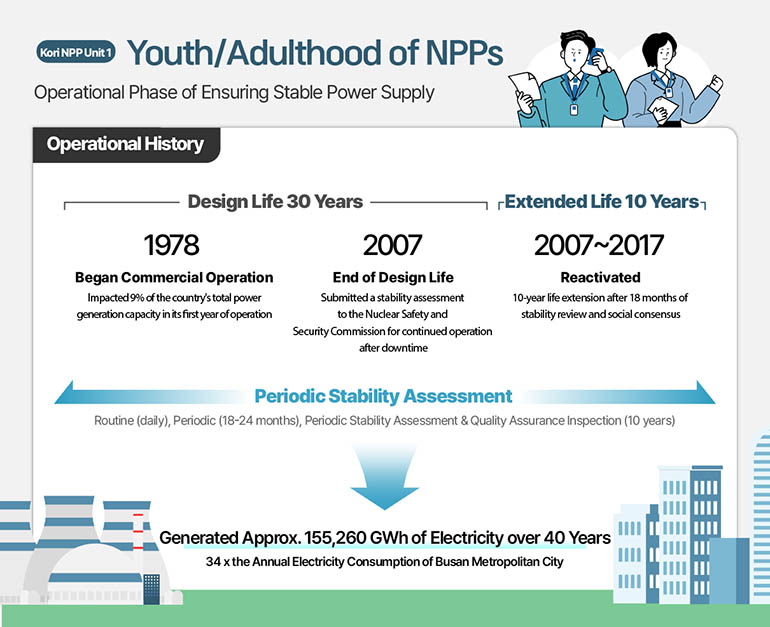
The minimum number of years for which a nuclear power plant can actively operate is called its “design life”. If a plant wants to continue operating after its design life has expired, its life can be extended in 10-year increments based on reliability through an independent review process.
After reaching the end of its 30-year design life from 1978 to 2007, Kori Unit 1 was authorized to continue operating in 2007 and its life was extended by 10 years until 2017. The reactor has now spent nearly 40 years of its youth and adulthood altogether, postponing retirement and choosing to remain in the active population for some time longer.
The criteria for extending the lifespan of nuclear power plants are very stringent. They undergo safety evaluations for about 18 months, and the opinions of local residents are also gathered. Even if a nuclear power plant was built long ago, it is rigorously assessed to modern technological standards. If, during the evaluation, it is determined that facility improvements are necessary, a specific period is designated to make these enhancements before moving on to the next stage of the evaluation process.
During the prime years of a nuclear power plant, periodic assessments of the stability of the reactor and related facilities are conducted. These include “daily or routine inspections”, “regular inspections” every 18 to 24 months, and “periodic safety evaluations” and “quality assurance inspections” every 10 years, always preparing for and addressing any issues.
An example of meeting all these rigorous management and standards is the Kori Unit 1. In its first year of operation, it handled 9% of South Korea's total power generation capacity, significantly impacting the power supply. Over 40 years, Kori Unit 1 produced 155,260 GWh of electricity, reportedly equivalent to 34 times the annual power usage of the entire Busan Metropolitan City
2017- The Old Age of NPPs Permanent Shutdown, Decommissioning and Ecosystem Restoration and Site Reuse
Old age is also said to be a time when the second chapter of our life begins. People enjoy retirement differently, some resting or taking on new challenges. Similarly, as nuclear power plants enter their old age, they cease operations and begin the decommissioning process. Afterwards, the site either returns to its original clean natural state or a new power plant may be constructed there.*
*In the United States, after decommissioning, the Shipping Port and Maine Yankee nuclear power plants have repurposed their sites into public green parks open to public while the Fort St. Vrain plant has been converted into a thermal power plant after full decommissioning. (Source: Korea Atomic Energy Research Institute)
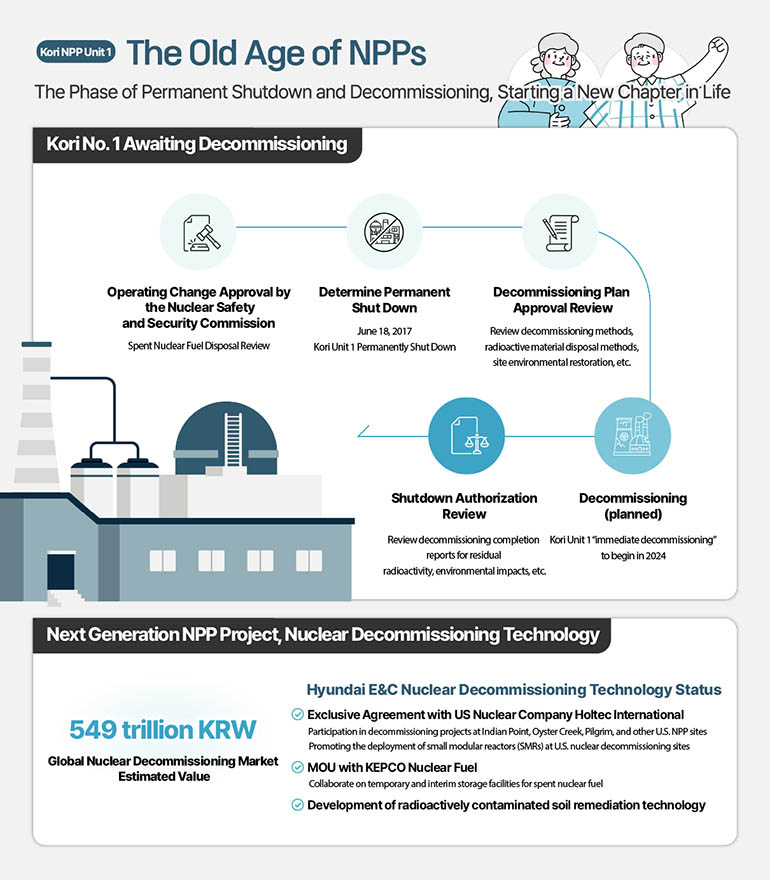
On June 18, 2017, the outdated Kori Unit 1 was permanently shut down at 24:00 hours and is awaiting decommissioning. After 40 years of youthful operation, it can be said to have retired from its job. Just like submitting a resignation letter to a company to retire, a permanent shutdown requires a license to change operations from the Nuclear Safety and Security Commission. Matters such as the spent fuel storage tank and the radioactive waste disposal system are intensively examined and approved before a permanent shutdown can take place.
A permanently shut down nuclear power plant does not immediately start decommissioning. KHNP must develop a decommissioning plan within five years of shutdown and submit it to the Nuclear Safety and Security Commission for approval. The decommissioning plan for the Kori Unit 1 was submitted in May 2021, but it is still under review. Once the plan is approved, decommissioning work is expected to commence this year. The decommissioning plan includes details such as the method of decommissioning, the removal of radioactive materials, the disposal of radioactive waste, and the restoration of the site to its original, radiation-free state.
Decommissioning methods are divided into immediate dismantlement, which takes place after a stabilization period of at least five years following permanent shutdown, and delayed decommissioning which occurs after several decades. The Kori Unit 1 has been designated for immediate decommissioning considering factors such as cost reduction and rapid site reuse. The most critical aspect is ensuring that all decommissioning processes prevent the external release of radioactivity, safeguarding workers and the surrounding environment from radioactive exposure. This focus on safety is why there are as many as 96 key technologies involved in nuclear decommissioning.
The Nuclear Safety and Security Commission will conduct periodic inspections to oversee a safe decommissioning process. However, the process doesn't end there. Once decommissioning is completed, the commission will review the decommissioning completion report submitted by KHNP. They will evaluate residual radioactivity at the site and the status of environmental restoration before finally approving the cessation of operations. Only after this approval is the decommissioning of the nuclear power plant officially completed, allowing the site to be repurposed for other uses.
The decommissioning of the Kori Unit 1 is imminent and is gaining a lot of attention. This is because if Korea can prove its nuclear power plant decommissioning technology, it can create new economic value by entering the global nuclear power plant decommissioning market, which is estimated to be worth nearly 549 trillion won*. Hyundai E&C, a leader in nuclear power plant technology, is making every effort to secure the capability to decommission nuclear power plants, which requires highly specialized expertise. It has signed an exclusive agreement with U.S. nuclear power corporation Holtec International to participate in the decommissioning of the Indian Point Nuclear Power Plant in the U.S. and will participate in future decommissioning projects at Oyster Creek Nuclear Power Plant and Pilgrim Nuclear Power Plant. Hyundai E&C is also the first Korean builder to introduce a small modular reactor (SMR) commercialization model at a nuclear decommissioning site in the U.S. In addition, Hyundai E&C is accumulating technical capabilities in the decommissioning business by performing technical services for radioactive contamination assessment and cost evaluation of decommissioned nuclear power plants (Kori Unit 1 and Wolseong Unit 1) in Korea with KHNP. The company has also signed business agreements with KEPCO on temporary and interim storage facilities for spent nuclear fuel to accelerate the promotion of next-generation nuclear power plants.
*Source: Global nuclear power plant decommissioning market(Bates White, 2017.12.)
The completion of Hyundai E&C's technological ecosystem, covering the entire lifecycle of a nuclear power plant from design to decommissioning, is just around the corner. Hyundai E&C is advancing the status of K-nuclear power plants, steadily growing its influence both in Korea and globally. The future of Hyundai E&C is eagerly anticipated.

